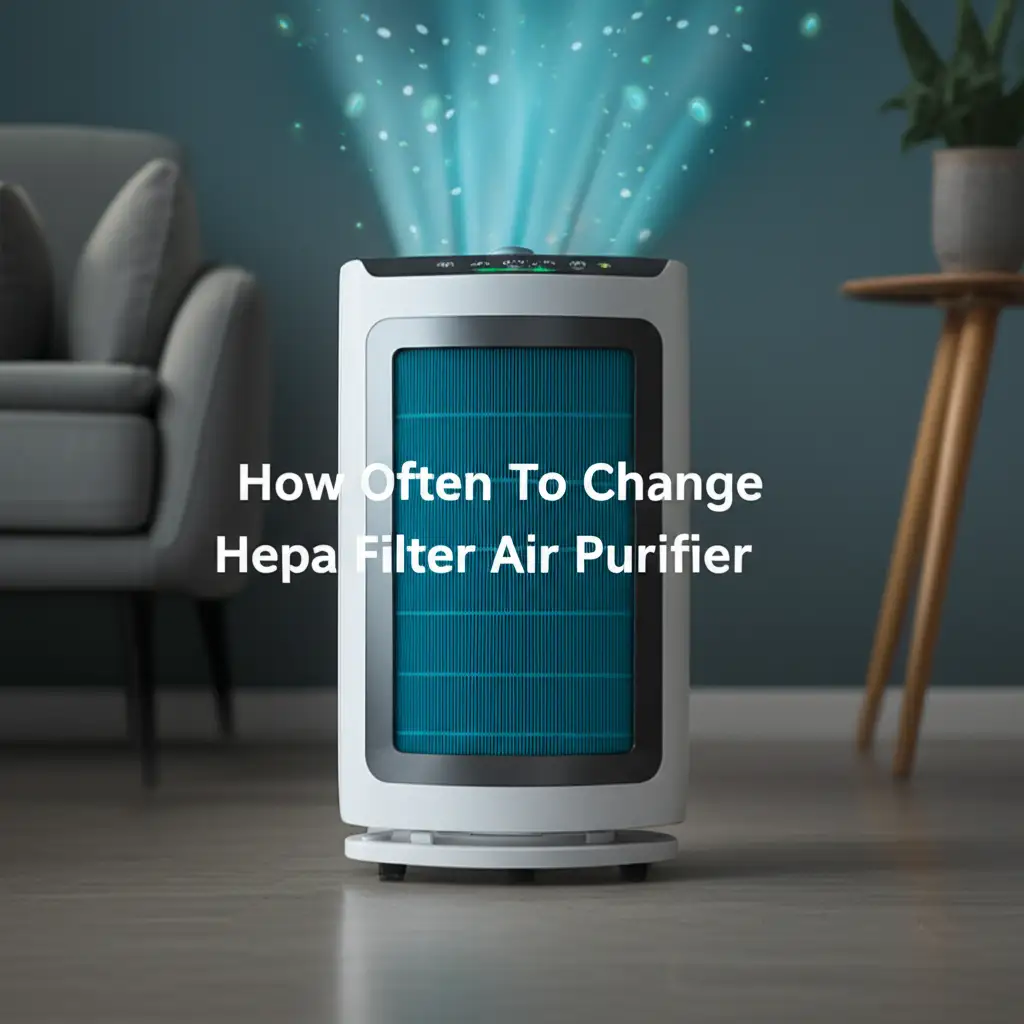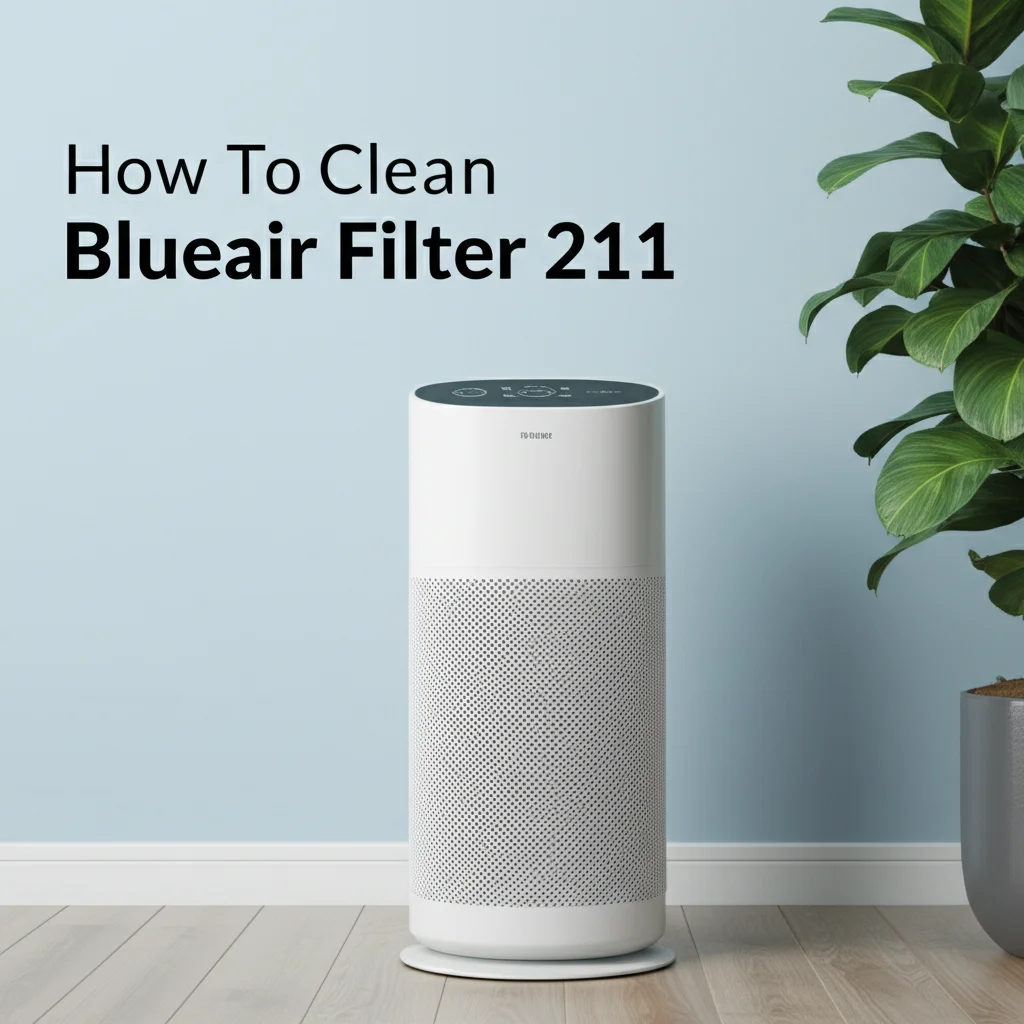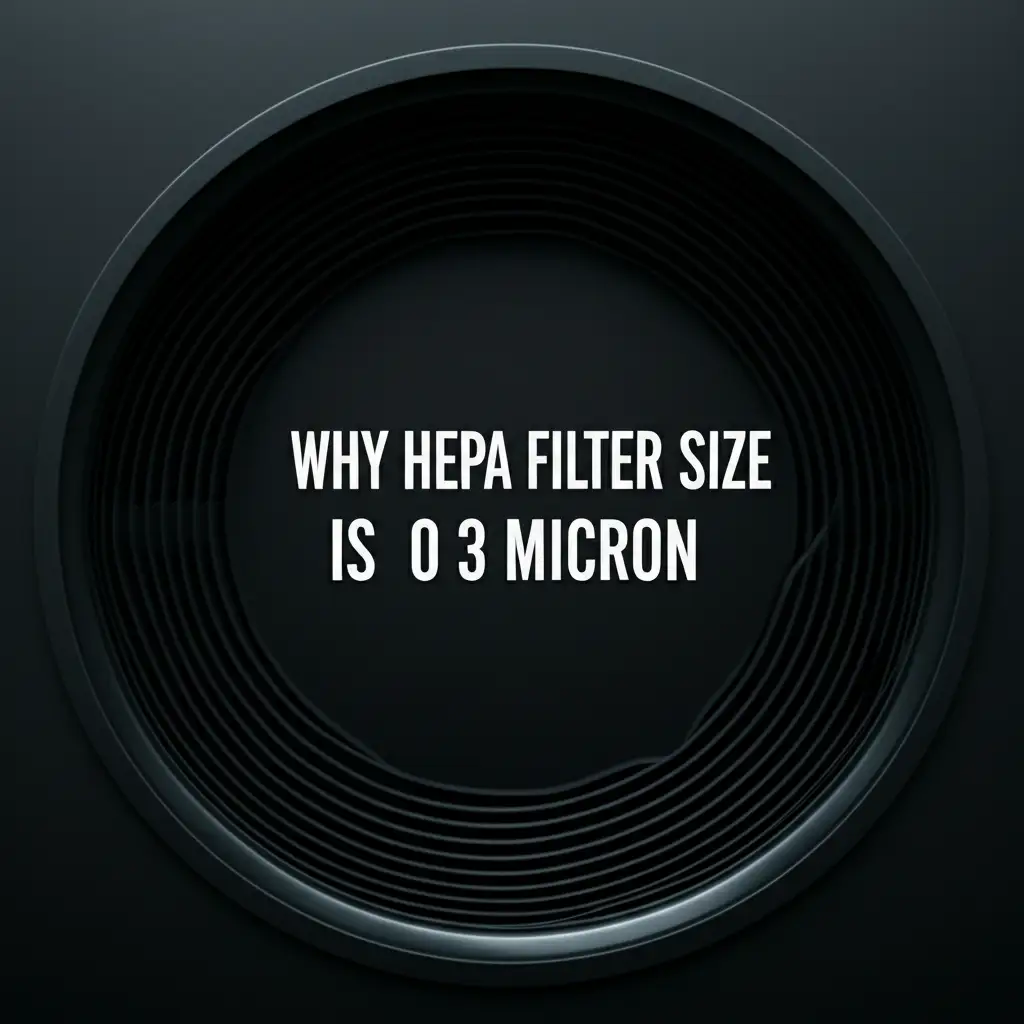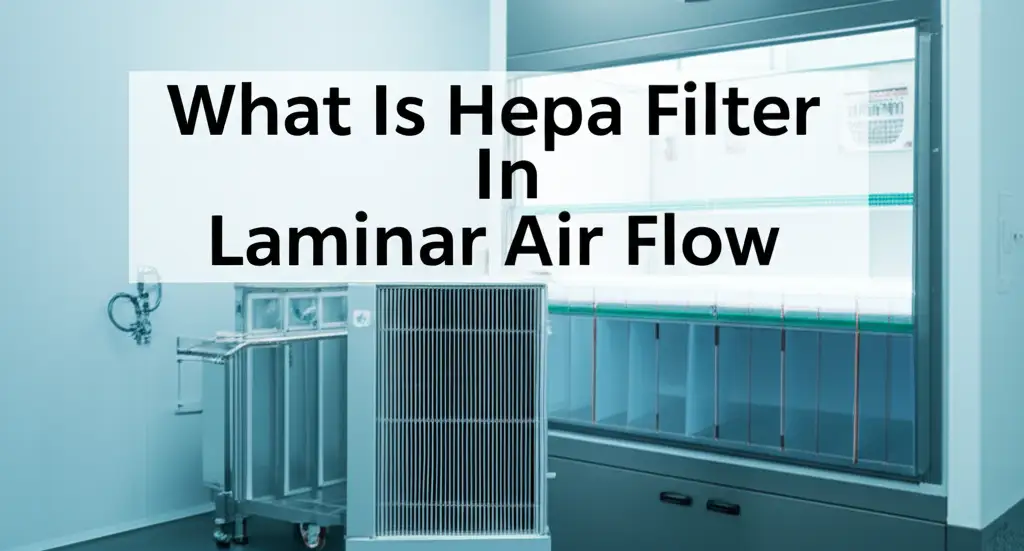· Todd Martin · Air Purifiers · 18 min read
How Often To Change Hepa Filter Air Purifier

When to Change Your HEPA Filter for Cleaner Air
Breathing clean air indoors is important for everyone. An air purifier helps remove harmful particles from your home environment. At the core of many of these devices sits the HEPA filter. Understanding how often to change HEPA filter air purifier components is key to keeping your air clean and your device working well.
I often get questions about filter maintenance. Many people wonder if their air purifier is still effective. A dirty filter can reduce your air purifier’s ability to clean the air. It might even circulate old pollutants. This guide helps you understand filter lifespan. We will look at factors that affect how often you need to replace your HEPA filter. We will also cover signs of a dirty filter. This article helps you maintain a healthy living space with minimal effort.
Takeaway
- Check your air purifier’s manual for specific HEPA filter replacement intervals.
- Consider factors like air quality, usage, and pets when determining filter changes.
- Look for signs like reduced airflow, increased noise, or musty odors.
- Never wash non-washable HEPA filters; always replace them when dirty.
Your HEPA filter in an air purifier typically needs replacement every 6 to 12 months. This timeframe depends on factors like air quality, how often you use the unit, and the presence of pets or smoke. Always check your specific air purifier model’s user manual for the most accurate recommendation.
Understanding HEPA Filters and Their Purpose
A HEPA filter is a crucial part of many air purification systems. HEPA stands for High-Efficiency Particulate Air. This type of filter captures tiny particles from the air. These particles include dust, pollen, pet dander, and smoke. The filter media is a mat of randomly arranged fibers. These fibers trap particles as air passes through them.
HEPA filters work by mechanical filtration. Particles get caught in the fibers. They either stick to the fibers or get physically blocked. This process helps create much cleaner indoor air. For people with allergies or asthma, a HEPA filter is especially important. It removes common triggers from the air. Without a functioning HEPA filter, your air purifier cannot effectively remove these airborne pollutants.
The design of a true HEPA filter ensures it traps 99.97% of airborne particles. These particles are as small as 0.3 microns. This tiny size includes most allergens and many bacteria. It is the gold standard for air purification effectiveness. Regular use of an air purifier with a HEPA filter improves indoor air quality. It makes your home a healthier place to live.
This filtration method does not use chemicals or ozone. It simply physically removes contaminants. The filter becomes saturated with trapped particles over time. When full, it loses its ability to capture new pollutants. This is why regular replacement is essential.
Factors Affecting HEPA Filter Lifespan
The “how often” question for HEPA filters has many answers. Several factors influence how long your HEPA filter lasts. Knowing these helps you predict when to change your HEPA filter air purifier element. Paying attention to these details can save you money and keep your air clean.
Air Quality in Your Home
The air quality inside your home directly impacts filter life. If you live in an area with high outdoor pollution, more particles will enter your home. Cooking fumes, smoke from fireplaces, or even candles also add to indoor air pollution. Homes near construction sites or busy roads might have dirtier air. A filter working harder to clean this air will get clogged faster. You will need to change the filter more often in such environments.
Air Purifier Usage Frequency
How often you run your air purifier matters a lot. A unit running 24/7 will collect particles much faster than one used for only a few hours a day. Continuous operation means constant air processing. This constant work loads the filter with more contaminants. If you run your air purifier only when you notice poor air, your filter might last longer. However, consistent use provides the best air quality benefits. Balance your usage with an understanding of faster filter wear.
Household Environment
Your living environment plays a big role. Homes with pets, especially those that shed a lot, fill the air with dander and hair. This rapidly clogs HEPA filters. Households with smokers also require more frequent filter changes. Smoke particles are very fine and sticky. They quickly reduce a filter’s efficiency. Even frequent dusting or vacuuming can stir up particles that the air purifier then captures. Children at home might also contribute to more dust and activity.
Manufacturer Guidelines
Every air purifier model comes with specific instructions. These instructions include recommended filter change intervals. Manufacturers design their filters and purifiers to work together for a set period. Some filters are larger or made with denser material. They might last longer. Always check your user manual first. This guide gives you the most accurate starting point for your specific device. Ignoring these guidelines can reduce your air purifier’s effectiveness.
Recommended HEPA Filter Change Schedule
Understanding the general guidelines for HEPA filter replacement is a good start. However, fine-tuning this schedule to your specific needs is even better. Knowing when to change your HEPA filter air purifier components ensures optimal performance.
General Replacement Guidelines
Most HEPA filters need replacement every 6 to 12 months. This is a common recommendation across many brands. Factors like continuous use and household environment will push this closer to the 6-month mark. For lighter use and cleaner environments, you might get closer to a year. It is a good practice to mark your calendar after each replacement. This helps you remember when the next change is due.
Think of it like an oil change for your car. You have a general timeframe, but your driving habits influence the exact timing. Similarly, your home’s air conditions dictate your filter’s life. Do not wait for complete failure; plan ahead for filter changes.
Checking Your Specific Model’s Manual
The best source of information is always your air purifier’s user manual. Manufacturers provide precise filter lifespan estimates for their specific models. Some purifiers use unique filter designs or multi-stage filtration systems. For example, some might combine a HEPA filter with an activated carbon pre-filter. These pre-filters often need cleaning or replacing more frequently. The manual will detail the maintenance schedule for each filter type.
For specific models like some Shark or Homedics purifiers, the manual provides the exact steps and intervals. If you need help with a particular filter, you can learn how to clean Homedics air purifier filter or similar brand-specific guidelines. Always consult the official documentation for your device. It ensures you follow the correct procedure.
Why Sticking to the Schedule Matters
Regular filter changes are vital for several reasons. First, a dirty filter loses its ability to capture pollutants. This means your air purifier is no longer effectively cleaning the air. It might just be circulating it. Second, an overloaded filter can strain the air purifier’s motor. This can lead to decreased efficiency and potentially shorten the unit’s lifespan.
A clean filter ensures optimal airflow. It allows the purifier to operate quietly and efficiently. Neglecting filter changes can lead to higher energy consumption. The motor works harder to pull air through a clogged filter. Replacing filters on time ensures you continue to enjoy the benefits of cleaner, healthier indoor air.
Signs Your HEPA Filter Needs Changing
Your air purifier often gives clues when its HEPA filter needs attention. Paying attention to these signs helps you know when to change your HEPA filter air purifier element. Ignoring these warnings can lead to poor air quality and potential damage to your unit.
Reduced Airflow
One of the most common signs is a noticeable drop in airflow from the purifier. When the HEPA filter becomes clogged with particles, air struggles to pass through it. You might feel a weaker stream of air coming out. Sometimes, the unit might even seem to be working harder but delivering less. This reduced efficiency means your air is not being cleaned effectively. It is a clear indicator that the filter is saturated.
Increased Noise from the Purifier
An air purifier usually operates quietly. If you notice your unit suddenly making more noise, it could be a sign of a clogged filter. The motor has to work harder to pull air through the restricted filter. This extra effort can cause the fan to spin faster or strain the motor, leading to louder operation. A noisy air purifier is often a sign of distress. It tells you the filter is fighting against a heavy load of trapped particles.
Musty Odors from the Purifier
Air purifiers should produce clean, fresh air. If you start smelling musty, stale, or unpleasant odors coming from your air purifier, it is a strong sign. The filter has likely accumulated a large amount of trapped pollutants, including mold spores or bacteria. These trapped particles can begin to produce odors. A clean filter removes odors. A dirty one can start creating them. This is an urgent sign for replacement.
Visible Dirt and Discoloration
While HEPA filters trap microscopic particles, over time, visible accumulation will occur. If you can access your HEPA filter, inspect it. A new HEPA filter is typically white or light-colored. A used filter will appear gray or dark brown, coated with dust and grime. This visible dirt confirms the filter is doing its job but is now full. Some manufacturers even design their filters with a color change indicator. If you have questions about general cleaning, understanding how to clean air purifier filter in general can be helpful, though HEPA filters often need replacement.
Filter Indicator Light
Many modern air purifiers have a built-in filter indicator light. This light illuminates when it is time to change the filter. These indicators track either hours of operation or monitor airflow resistance. They provide a convenient reminder. While useful, do not solely rely on it. Your environmental factors might require earlier changes. Always check the physical filter and airflow in conjunction with the light. After replacing the filter, remember to reset the indicator light according to your manual.
Step-by-Step Guide: How to Change Your HEPA Filter
Changing your HEPA filter is a simple process. You do not need special tools or skills. Knowing how to change your HEPA filter air purifier components ensures you maintain a healthy home. Follow these steps for a smooth replacement.
Gather Your Supplies
Before you start, make sure you have everything you need. You will need a new, compatible HEPA filter. Always use filters recommended by your air purifier’s manufacturer. Using generic filters might affect performance or even void your warranty. I also recommend wearing gloves and a dust mask. This protects you from accumulated dust and allergens. Have a trash bag ready for the old filter.
Turn Off and Unplug the Unit
Safety first! Always turn off your air purifier and unplug it from the wall outlet. This prevents accidental starts during the filter change. It protects you from electrical hazards. Never attempt to open or work on the unit while it is powered on.
Locate the Filter Compartment
Most air purifiers have a dedicated compartment for filters. This is usually located on the back, side, or bottom of the unit. Some models might require you to remove a front panel or grill. Consult your air purifier’s manual if you are unsure where the filter is. You might find guidance on specific models, like how to change HEPA filter on Kenmore Elegance or other brands, in your manual or online resources.
Remove the Old Filter
Once you find the compartment, open it. Carefully remove the old HEPA filter. It will likely be dusty and dirty. Handle it by the edges if possible to avoid direct contact with the trapped pollutants. Place the old filter directly into your trash bag to contain the dust. You might notice a carbon pre-filter or other filters. Remove these as well if they also need replacement. For a multi-stage system, understanding does carbon filter go before or after HEPA filter helps ensure correct reassembly.
Clean the Housing
This is a good time to give the inside of your air purifier a quick clean. Use a soft, dry cloth or a vacuum cleaner with a brush attachment. Gently remove any dust or debris from the filter housing and grilles. Do not use water or cleaning solutions inside the unit. This step ensures clean air can flow freely through the system.
Insert the New Filter
Unpack your new HEPA filter. Check for any arrows indicating airflow direction. Most filters have these to ensure correct installation. Slide the new HEPA filter into the compartment. Make sure it fits snugly. There should be no gaps around the edges. Gaps would allow unfiltered air to bypass the filter. Close the filter compartment door or panel securely.
Reset the Filter Indicator (If Applicable)
Many air purifiers have a filter life indicator light. After installing a new filter, you need to reset this indicator. The method varies by model. It often involves pressing and holding a button for a few seconds. Refer to your manual for the exact instructions. Resetting the indicator ensures it will accurately remind you when the next filter change is due.
The Importance of Regular Filter Replacement
Regular HEPA filter replacement is not just about keeping your air purifier running. It is about maintaining a truly healthy indoor environment. I cannot stress enough the benefits of this simple maintenance task. It impacts your health, your air quality, and even your utility bills.
Maintaining Optimal Air Purification
The primary job of your air purifier is to remove pollutants. A fresh HEPA filter excels at this task. It efficiently captures microscopic particles, allergens, and odors. A clogged filter cannot do its job properly. It allows more contaminants to remain in the air you breathe. This defeats the purpose of having an air purifier. Replacing the filter ensures your unit performs at its peak. It continues to deliver the clean air you expect and need.
Protecting Your Health
Indoor air can be 2 to 5 times more polluted than outdoor air. This is a common concern for people with respiratory issues. A clean HEPA filter effectively removes triggers like pollen, dust mites, pet dander, and mold spores. It reduces your exposure to these harmful particles. Dirty filters fail to protect you. They might even become breeding grounds for bacteria or mold. Regular replacement is a proactive step for your family’s health. It helps reduce allergy symptoms and improves overall respiratory comfort.
Extending the Life of Your Air Purifier
A heavily clogged filter forces your air purifier’s motor to work much harder. The motor strains to pull air through the dense, dirty media. This constant strain generates more heat. It can lead to premature wear and tear on the motor and fan components. Think of it like running your car with a clogged air filter. It reduces performance and stresses the engine. Regularly changing the HEPA filter reduces this strain. It helps extend the overall lifespan of your air purifier. This saves you money in the long run by avoiding costly repairs or replacements of the unit itself.
Energy Efficiency Benefits
When an air purifier’s motor struggles against a clogged filter, it consumes more energy. The unit tries to compensate for the reduced airflow by drawing more power. This results in higher electricity bills. A clean filter allows air to flow freely. The motor can operate efficiently at its intended power level. This makes your air purifier more energy-efficient. It saves you money on electricity while still providing superior air quality. It is a win-win situation for your wallet and your indoor environment. Maintaining any household filter, whether in your air purifier or elsewhere, is important. For example, understanding why should you change your air conditioner filter highlights similar benefits for your HVAC system’s efficiency and air quality.
Common Misconceptions About HEPA Filters
There are some common misunderstandings about HEPA filters. Addressing these helps you better manage your air purifier maintenance. Knowing the facts ensures you get the most out of your filter.
Washing HEPA Filters
This is a very common question I hear: “Can I wash the HEPA filter on my air purifier?” The answer is almost always no. True HEPA filters are made of very fine, dense, paper-like material. Washing them destroys their delicate structure. It breaks down the fibers. This makes the filter ineffective at trapping particles. Once wet, they cannot filter air properly.
Some air purifiers have a “washable” pre-filter. This pre-filter captures larger particles like pet hair and lint. It is usually a mesh or foam filter. You can wash these pre-filters according to manufacturer instructions. However, the main HEPA filter itself is disposable. If you try to wash a true HEPA filter, you will ruin it. You will then need to buy a new one anyway. For more detail, you can read about can I wash the HEPA filter on my air purifier.
”Lifetime” Filters
Some manufacturers advertise “permanent” or “lifetime” filters. This term can be misleading. A “permanent” filter typically means it is a filter that you clean, not replace. These are often washable pre-filters or electrostatic filters. They are designed to be vacuumed or rinsed. However, they are not true HEPA filters. They do not offer the same filtration efficiency as disposable HEPA filters. They usually only capture larger particles.
Even if an air purifier claims a “permanent HEPA-type” filter, it might mean it’s only a partial HEPA or a vacuumable filter, not a true, disposable HEPA filter. Always check the specific type of filtration. A true HEPA filter cannot last a “lifetime” without replacement. It becomes clogged over time.
Ignoring Indicator Lights
Many modern air purifiers have an indicator light. This light tells you when to change or clean the filter. Some people ignore this light, thinking they can stretch the filter life. This is a mistake. The light activates based on usage hours or airflow restriction. It serves as a crucial reminder.
Ignoring the indicator means you are running your air purifier with a dirty, ineffective filter. This reduces its purification power. It also puts strain on the motor. Always pay attention to these lights. Treat them as a signal that maintenance is due. After replacement, remember to reset the indicator.
FAQ Section
Can I wash my HEPA filter to extend its life?
No, you cannot wash a true HEPA filter. True HEPA filters are made from dense, paper-like fibers that lose their filtering capability when wet. Washing them destroys their structure. This makes them ineffective. Some air purifiers have washable pre-filters, but the main HEPA filter requires replacement.
How do I know if my air purifier has a HEPA filter?
Check your air purifier’s product description, packaging, or user manual. It will clearly state if it uses a “True HEPA” filter. Some models might use “HEPA-type” or “HEPA-like” filters, which are not as efficient. A true HEPA filter captures 99.97% of particles 0.3 microns or larger.
What happens if I don’t change my HEPA filter?
If you do not change your HEPA filter, its efficiency drops significantly. It will no longer effectively remove pollutants from the air. The air purifier may also produce a musty smell, become noisier, and consume more energy. It can also strain the motor, potentially shortening the unit’s lifespan.
Are all HEPA filters the same?
While all true HEPA filters meet the 99.97% efficiency standard for 0.3-micron particles, their physical dimensions and designs vary widely. You must buy a replacement filter specifically made for your air purifier model. Filters from different brands or models are usually not interchangeable.
Does a HEPA filter remove odors?
A standard HEPA filter primarily removes particles like dust, pollen, and pet dander. It does not effectively remove odors or gases. For odor removal, an air purifier usually needs an additional activated carbon filter. Many air purifiers combine a HEPA filter with a carbon filter for comprehensive air cleaning.
How much do HEPA replacement filters cost?
The cost of HEPA replacement filters varies greatly depending on the air purifier brand, model, and filter size. Prices can range from $20 to over $100 per filter. Investing in genuine manufacturer filters ensures optimal performance and fit. Consider the replacement cost when buying an air purifier.
Conclusion
Understanding how often to change HEPA filter air purifier components is vital for maintaining healthy indoor air. We have explored the crucial role of HEPA filters in capturing airborne pollutants. We have also discussed the factors that influence their lifespan, from household environment to usage frequency. Recognizing the signs of a clogged filter, like reduced airflow or increased noise, empowers you to act promptly.
Regularly replacing your HEPA filter ensures your air purifier continues to operate at peak efficiency. It effectively removes allergens, dust, and other harmful particles from your home. This maintenance practice protects your health and extends the life of your appliance. I recommend you establish a consistent filter replacement schedule for your unit. Check your manual for specific guidance. Do not forget to reset the filter indicator light after each change. Prioritize this simple step to ensure your home remains a sanctuary of clean, fresh air. Your lungs will thank you.
- HEPA filter
- air purifier maintenance
- filter replacement
- indoor air quality
- air purification
- home health
- filter lifespan





